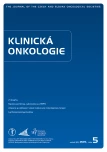Treatment of Malignant Peritoneal Mesothelioma
Authors:
Miroslav Levý 1; Ludmila Boublíková 2; Tomáš Büchler 2; Jaromír Šimša 1
Authors place of work:
Chirurgická klinika 1. LF UK a Thomayerovy nemocnice, Praha
1; Onkologická klinika 1. LF UK a Thomayerovy nemocnice, Praha
2
Published in the journal:
Klin Onkol 2019; 32(5): 333-337
Category:
Přehled
doi:
https://doi.org/10.14735/amko2019333
Summary
Malignant mesothelioma is a highly malignant disease that most often occurs in the pleura of the thoracic cavity, followed by the peritoneum, pericardium, or tinea vaginalis testis. Malignant peritoneal mesothelioma (MPM) accounts for 10–15% of all mesotheliomas. The most significant risk factor for MPM is exposure to asbestos. There is no specific symptomatology, and imaging (computed tomography) and histopathology are crucial for diagnosis. There are no generally accepted guidelines for radical treatment of MPM. Previously, the prognosis of MPM patients was poor, with survival of up to 1 year. However, median survival of patients who are suitable candidates for radical therapy is currently 3–5 years. A combination of cytoreductive surgery (CRS) and hyperthermic perioperative chemotherapy (HIPEC) is recommended in selected patients, while chemotherapy alone has insufficient efficacy. Systemic chemotherapy remains the only treatment option for patients who are unsuitable for CRS and HIPEC. In selected patients scheduled for or currently undergoing CRS and HIPEC, surgery may be performed in combination with systemic chemotherapy in the neoadjuvant or adjuvant setting; however, the benefit is unclear. There are no recommendations for follow-up of MPM patients after radical surgery. Existing guidelines for the pleural form (e.g., those issued by the European Society for Medical Oncology) do not specify the frequency or method of investigation. In the absence of specific serum markers, only CA 125 and mesothelin are generally available. Imaging methods include ultrasonography, computed tomography, and magnetic resonance imaging.
Keywords:
mesothelioma – cytoreductive surgery – intraperitoneal chemotherapy
Zdroje
1. Hassan R, Alexander R, Antman K et al. Current treatment options and biology of peritoneal mesothelioma: meeting summary of the first NIH peritoneal mesothelioma conference. Ann Oncol 2006; 17 (11): 1615–1619. doi: 10.1093/annonc/mdl060.
2. Deraco M, Bartlett D, Kusamura S et al. Consensus statement on peritoneal mesothelioma. J Surg Oncol 2008; 98 (4): 268–272. doi: 10.1002/jso.21055.
3. Sugarbaker PH, Turaga KK, Alexander Jr HR et al. Management of malignant peritoneal mesothelioma using cytoreductive surgery and perioperative chemotherapy. J Oncol Pract 2016; 12 (10): 928–936. doi: 10.1200/JOP.2016.011908.
4. Baas P, Fennell D, Kerr KM et al. Malignant pleural mesothelioma: ESMO Clinical Practice Guidelines for diagnosis, treatment and follow-up. Ann Oncol 2015; 26 (Suppl 5): 31–39. doi: 10.1093/annonc/mdv199.
5. National Comprehensive Cancer Network. Malignant Pleural Mesothelioma. NCCN Guidelines Version 2.2018. [online]. Available from: https: //www.nccn.org/professionals/physician_gls/default.aspx.
6. cancer.gov. National Cancer Institute. Malignant Mesothelioma Treatment (PDQ®) – Health Professional Version. [online]. Available from: https: //www.cancer.gov/types/mesothelioma/hp/mesothelioma-treatment-pdq.
7. Rupert K, Třeška V. Maligní mezoteliom v peritoneální dutině – kazuistika. Rozhl Chir 2015; 94 (4): 166–169.
8. Šafář P. Primární peritoneální karcinom. Postgraduální medicína 2008; 1: 61–65.
9. Modrá kniha České onkologické společnosti. Masarykův onkologický ústav 2018.
10. Dušek L, Mužík J, Kubásek M et al. Epidemiologie zhoubných nádorů v České republice. Masarykova univerzita 2005. [online]. Dostupné z: https: //www.svod.cz/.
11. Price B, Ware A. Time trend of mesothelioma incidence in the United States and projection of future cases: an update based on SEER data for 1973 through 2005. Crit Rev Toxicol 2009; 39: 576–588. doi: 10.1080/10408440903044928.
12. UpToDate.com. Alexander HR. Malignant peritoneal mesothelioma: epidemiology, risk factors, clinical presentation, diagnosis, and staging. [online]. Available from: https: //www.uptodate.com/contents/malignant-peritoneal-mesothelioma-epidemiology-risk-factors-clinical-presentation-diagnosis-and-staging.
13. Bruno F, Baratti D, Martinetti A et al. Mesothelin and osteopontin as circulating markers of diffuse malignant peritoneal mesothelioma: a preliminary study. Eur J Surg Oncol 2018; 44 (6): 792–798. doi: 10.1016/ j.ejso.2018.02.010.
14. Yan TD, Deraco M, Eliad D et al. A novel tumor-node-metastasis (TNM) staging system of diffuse malignant peritoneal mesothelioma using outcome analysis of a multi-institutional database. Cancer 2011; 117 (9): 1185–1863. doi: 10.1002/cncr.25640.
15. Baratti D, Kusamura S, Cabras AD et al. Cytoreductive surgery with selective versus complete parietal peritonectomy followed by hyperthermic intraperitoneal chemotherapy in patients with diffuse malignant peritoneal mesothelioma: a controlled study. Ann Surg Oncol 2012; 19 (5): 1416–1424. doi: 10.1245/s10434-012-2237-2.
16. Randle RW, Swett KR, Swords DS et al. Efficacy of cytoreductive surgery with hyperthermic intraperitoneal chemotherapy in the management of malignant ascites. Ann Surg Oncol 2014; 21 (5): 1474–1479. doi: 10.1245/s10434-013-3224-y.
17. Helm JH, Miura JT, Glenn JA et al. Cytoreductive surgery and hyperthermic intraperitoneal chemotherapy for malignant peritoneal mesothelioma: a systematic review and meta-analysis. Ann Surg Oncol 2015; 22 (5): 1686–1693. doi: 10.1245/s10434-014-3978-x.
18. Turner K, Varghese S, Alexander HR Jr. Current concepts in the evaluation and treatment of patients with diffuse malignant peritoneal mesothelioma. J Natl Compr Cancer Netw 2012; 10 (1): 49–57.
19. Salo SA, Ilonen I, Laaksonen S et al. Epidemiology of malignant peritoneal mesothelioma: a population-based study. Cancer Epidemiol 2017; 51: 81–86. doi: 10.1016/ j.canep.2017.10.008.
Štítky
Dětská onkologie Chirurgie všeobecná OnkologieČlánek vyšel v časopise
Klinická onkologie

2019 Číslo 5
- Metamizol jako analgetikum první volby: kdy, pro koho, jak a proč?
- Nejasný stín na plicích – kazuistika
- Neodolpasse je bezpečný přípravek v krátkodobé léčbě bolesti
- Léčba akutní pooperační bolesti z pohledu ortopeda
- MUDr. Lenka Klimešová: Multioborová vizita může být klíčem k efektivnější perioperační léčbě chronické bolesti
Nejčtenější v tomto čísle
- Alopecie a poškození vlasů indukované onkologickou terapií
- Pseudomyxom peritonea
- Maligní peritoneální mezoteliom a jeho léčba
- Maligní nádory peritonea – úvod do problematiky
